OCZ Vertex 4 Review (256GB, 512GB)
by Anand Lal Shimpi on April 4, 2012 9:00 AM ESTSequential Read/Write Speed
To measure sequential performance I ran a 1 minute long 128KB sequential test over the entire span of the drive at a queue depth of 1. The results reported are in average MB/s over the entire test length.
As impressive as the random read/write speeds were, at low queue depths the Vertex 4's sequential read speed is problematic:

Curious as to what's going on, I ran AS-SSD and came away with much better results:
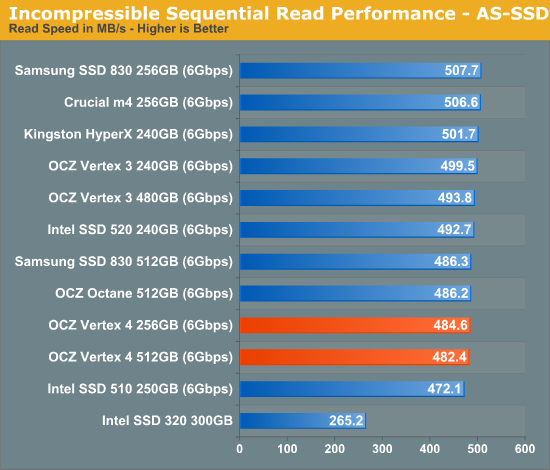
Finally I turn to ATTO, giving me the answer I'm looking for. The Vertex 4's sequential read speed is slow at low queue depths with certain workloads, move to larger transfer sizes or high queue depths and the problem resolves itself:
The problem is that many sequential read operations for client workloads occur at 64 – 128KB transfer sizes, and at a queue depth of 1 - 3. Looking at the ATTO data above you'll see that this is exactly the weak point of the Vertex 4.
I went back to Iometer and varied queue depth with our 128KB sequential read test and got a good characterization of the Vertex 4's large block, sequential read performance:
The Vertex 4 performs better with heavier workloads. While other drives extract enough parallelism to deliver fairly high performance with only a single IO in the queue, the Vertex 4 needs 2 or more for large block sequential reads. Heavier read workloads do wonderfully on the drive, ironically enough it's the lighter workloads that are a problem. It's the exact opposite of what we're used to seeing. As this seemed like a bit of an oversight, I presented OCZ with my data and got some clarification.
Everest 2 was optimized primarily for non-light workloads where higher queuing is to be expected. Extending performance gains to lower queue depths is indeed possible (the Everest 1 based Octane obviously does fine here) but it wasn't deemed a priority for the initial firmware release. OCZ instead felt it was far more important to have a high-end alternative to SandForce in its lineup. Given that we're still seeing some isolated issues on non-Intel SF-2281 drives, the sense of urgency does make sense.
There are two causes for the lower than expected, low queue depth sequential read performance. First, OCZ doesn't currently enable NCQ streaming for queue depths less than 3. This one is a simple fix. Secondly, the Everest 2 doesn't currently allow pipelined read access from more than 8 concurrent NAND die. For larger transfers and queue depths this isn't an issue, but smaller transfers and lower queue depths end up delivering much lower than expected performance.
To confirm that I wasn't crazy and the Vertex 4 was capable of high, real-world sequential read speeds I created a simple test. I took a 3GB archive and copied it from the Vertex 4 to a RAM drive (to eliminate any write speed bottlenecks). The Vertex 4's performance was very good:
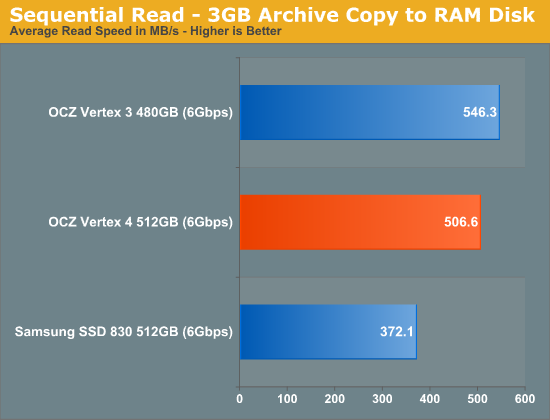
Clearly the Vertex 4 is capable of reading at very high rates – particularly when it matters, however the current firmware doesn't seem tuned for any sort of low queue depth operation.
Both of these issues are apparently being worked on at the time of publication and should be rolled into the next firmware release for the drive (due out sometime in late April). Again, OCZ's aim was to deliver a high-end drive that could be offered as an alternative to the Vertex 3 as quickly as possible.
Update: Many have been reporting that the Vertex 4's performance is dependent on having an active partition on the drive due to its NCQ streaming support. While this is true, it's not the reason you'll see gains in synthetic tests like Iometer. If you don't fill the drive with valid data before conducting read tests, the Vertex 4 returns lower performance numbers. Running Iometer on a live partition requires that the drive is first filled with data before the benchmark runs, similar to what we do for our Iometer read tests anyway. The chart below shows the difference in performance between running an Iometer sequential read test on a physical disk (no partition), an NTFS partition on the same drive and finally the physical disk after all LBAs have been written to:
Notice how the NTFS and RAW+precondition lines are identical, it's because the reason for the performance gain here isn't NCQ streaming but rather the presence of valid data that you're reading back. Most SSDs tend to give unrealistically high performance numbers if you read from them immediately following a secure erase so we always precondition our drives before running Iometer. The Vertex 4 just happens to do the opposite, but this has no bearing on real world performance as you'll always be reading actual files in actual use.
Despite the shortcomings with low queue depth sequential read performance, the Vertex 4 dominated our sequential write tests, even at low queue depths. Only the Samsung SSD 830 is able to compete:
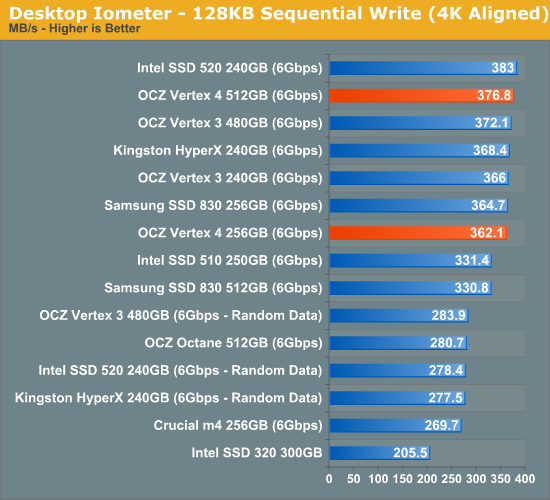
Technically the SF-2281 drives equal the Vertex 4's performance, but that's only with highly compressible data. Large sequential writes are very often composed of already compressed data, which makes the real world performance advantage of the Vertex 4 tangible.
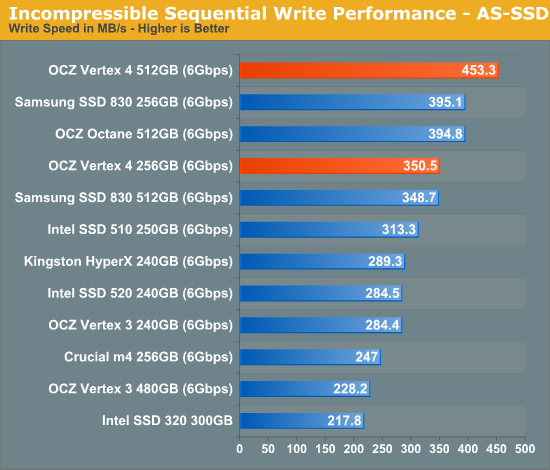
AS-SSD gives us another taste of the performance of incompressible data, which again is very good on the Vertex 4. As far as writes are concerned, there's really no beating the Vertex 4.


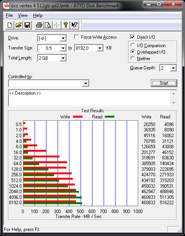
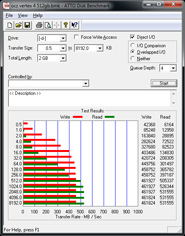

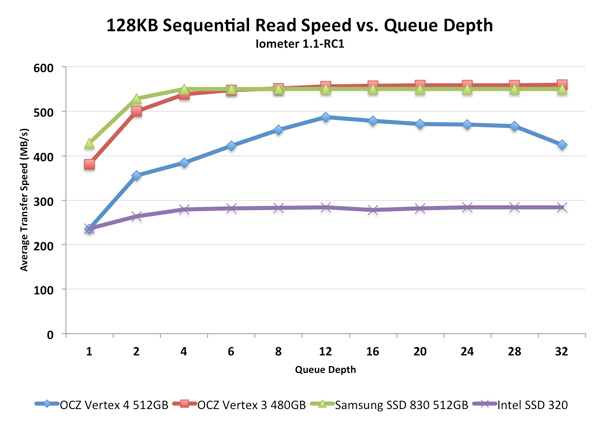
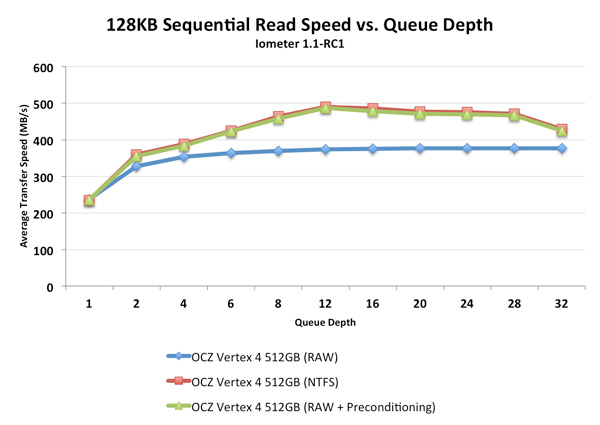








127 Comments
View All Comments
vol7ron - Wednesday, April 4, 2012 - link
Exactly, and it's where power consumption matters even more.I'd also like to see where the OWC drives fit in.
ViviTheMage - Wednesday, April 4, 2012 - link
There are plenty of lower pwer SSD's that have similiar tasty iops, so you won't be disappointed...the falvouring is a little different, but you will still enjoy it.ckryan - Wednesday, April 4, 2012 - link
I very much expect the next generation of Marvell drives to look similar in some respects to the V4.I applaud OCZ for doing things differently, but they're probably just trying to beat the next wave of Marvell powered drives to market, not making up for SFs immediate deficiencies.
ViviTheMage - Wednesday, April 4, 2012 - link
Do you think Marvell can release a drive with as many delicious iops?Kristian Vättö - Wednesday, April 4, 2012 - link
Not Marvell, because they only make controllers ;-)Plextor M3 Pro is already providing up to 75K/69K IOPS (read/write). Marvell released a new controller a couple of weeks ago and at least according to the press release, random speeds should be substantially improved with a great firmware. How fast is still a question but I wouldn't be surprised to see figures similar to Indilinx 2.
And as a side note, Plextor M3 review should be up later today or tomorrow as well :-)
ckryan - Wednesday, April 4, 2012 - link
The M3P is fantastic. It's like the V4 without the compromise. Plus, I'd take better low QD performance any day of the week over high QD performance. The M3P is a lot more balanced.Plus, yeah, the 830 is awesome too, but it doesn't really cater to the super high 4Krw crowd. I feel like OCZ just needed to get this drive out before then next wave of similar drives hit, and will later tweak the FW to better accommodate desktop workloads.
But it does accomplish one thing -- whatever FW/FTL they strapped on that drive doesn't look like anything else at the moment. It's certainly easy to see in an ocean of charts.
I think OCZ just mainly wanted to reverse their years of SF marketing practice with the V4 -- Latency is now important. Compressible data is out. They just had to wait until they had a product that could match the paper specs of the 2281. Ironically, I'd take it over a V3 any day of the week, but the 2281 is still better with most workloads.
etamin - Wednesday, April 4, 2012 - link
Perhaps the V4 may turn out to be a more economical choice though because it is entirely developed in house.jwilliams4200 - Thursday, April 5, 2012 - link
LOL. Except for the rebadged Marvell controller and the flash memory, yeah, entirely in house.rw1986 - Friday, April 6, 2012 - link
rebadged MRVL controller?? can u elaboratejwilliams4200 - Friday, April 6, 2012 - link
Did you ever wonder why Indilinx took so long to come out with a 2nd gen controller after their first was so popular?Well, they didn't. Not really. OCZ does not want you to know that they have a relationship with Marvell, and their new controller is basically a Marvell 88SS9187. It would be hard to justify the shareholder money OCZ spent on acquiring Indilinx if the truth were known.
If you have any doubts, look at the press release from Marvell press release bullet points and compare them to the features OCZ is touting in the Vertex 4. They are identical.
http://www.marvell.com/company/news/pressDetail.do...